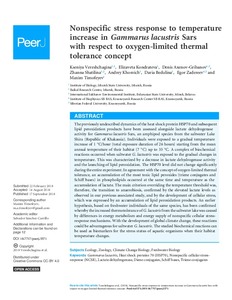Показать сокращенную информацию
Nonspecific stress response to temperature increase in Gammarus lacustris Sars with respect to oxygen-limited thermal tolerance concept
| Автор | Kseniya, Vereshchagina | |
| Автор | Elizaveta, Kondrateva | |
| Автор | Denis, Axenov-Gribanov | |
| Автор | Zhanna, Shatilina | |
| Автор | Andrey, Khomich | |
| Автор | Daria, Bedulina | |
| Автор | Задереев, Егор | |
| Автор | Maxim, Timofeyev | |
| Дата внесения | 2019-07-01T07:25:57Z | |
| Дата, когда ресурс стал доступен | 2019-07-01T07:25:57Z | |
| Дата публикации | 2018-09 | |
| Библиографическое описание | Kseniya, Vereshchagina. Nonspecific stress response to temperature increase in Gammarus lacustris Sars with respect to oxygen-limited thermal tolerance concept [Текст] / Vereshchagina Kseniya, Kondrateva Elizaveta, Axenov-Gribanov Denis, Shatilina Zhanna, Khomich Andrey, Bedulina Daria, Егор Задереев, Timofeyev Maxim // PeerJ. — 2018. | |
| ISSN | 21678359 | |
| URI (для ссылок/цитирований) | https://peerj.com/articles/5571/ | |
| URI (для ссылок/цитирований) | https://elib.sfu-kras.ru/handle/2311/110663 | |
| Аннотация | The previously undescribed dynamics of the heat shock protein HSP70 and subsequent lipid peroxidation products have been assessed alongside lactate dehydrogenase activity for Gammarus lacustris Sars, an amphipod species from the saltwater Lake Shira (Republic of Khakassia). Individuals were exposed to a gradual temperature increase of 1 ◦C/hour (total exposure duration of 26 hours) starting from the mean annual temperature of their habitat (7 ◦C) up to 33 ◦C. A complex of biochemical reactions occurred when saltwater G. lactustris was exposed to the gradual changes in temperature. This was characterized by a decrease in lactate dehydrogenase activity and the launching of lipid peroxidation. The HSP70 level did not change significantly during the entire experiment. In agreement with the concept of oxygen-limited thermal tolerance, an accumulation of the most toxic lipid peroxides (triene conjugates and Schiff bases) in phospholipids occurred at the same time and temperature as the accumulation of lactate. The main criterion overriding the temperature threshold was, therefore, the transition to anaerobiosis, confirmed by the elevated lactate levels as observed in our previous associated study, and by the development of cellular stress, which was expressed by an accumulation of lipid peroxidation products. An earlier hypothesis, based on freshwater individuals of the same species, has been confirmed whereby the increased thermotolerance ofG. lacustrisfrom the saltwater lake was caused by differences in energy metabolism and energy supply of nonspecific cellular stressresponse mechanisms. With the development of global climate change, these reactions could be advantageous for saltwater G. lacustris. The studied biochemical reactions can be used as biomarkers for the stress status of aquatic organisms when their habitat temperature changes. | |
| Тема | Gammarus lacustris | |
| Тема | Heat shock proteins 70 (HSP70) | |
| Тема | Nonspecific cellular stressresponse (NCSR) | |
| Тема | Lactate dehydrogenase | |
| Тема | Diene conjugates | |
| Тема | Schiff bases | |
| Тема | Triene conjugates | |
| Название | Nonspecific stress response to temperature increase in Gammarus lacustris Sars with respect to oxygen-limited thermal tolerance concept | |
| Тип | Journal Article | |
| Тип | Published Journal Article | |
| ГРНТИ | 34.35.15 | |
| Дата обновления | 2019-07-01T07:25:57Z | |
| DOI | 10.7717/peerj.5571 | |
| Институт | Институт фундаментальной биологии и биотехнологии | |
| Подразделение | Кафедра биофизики | |
| Журнал | PeerJ | |
| Квартиль журнала в Scopus | Q1 | |
| Квартиль журнала в Web of Science | Q2 |

